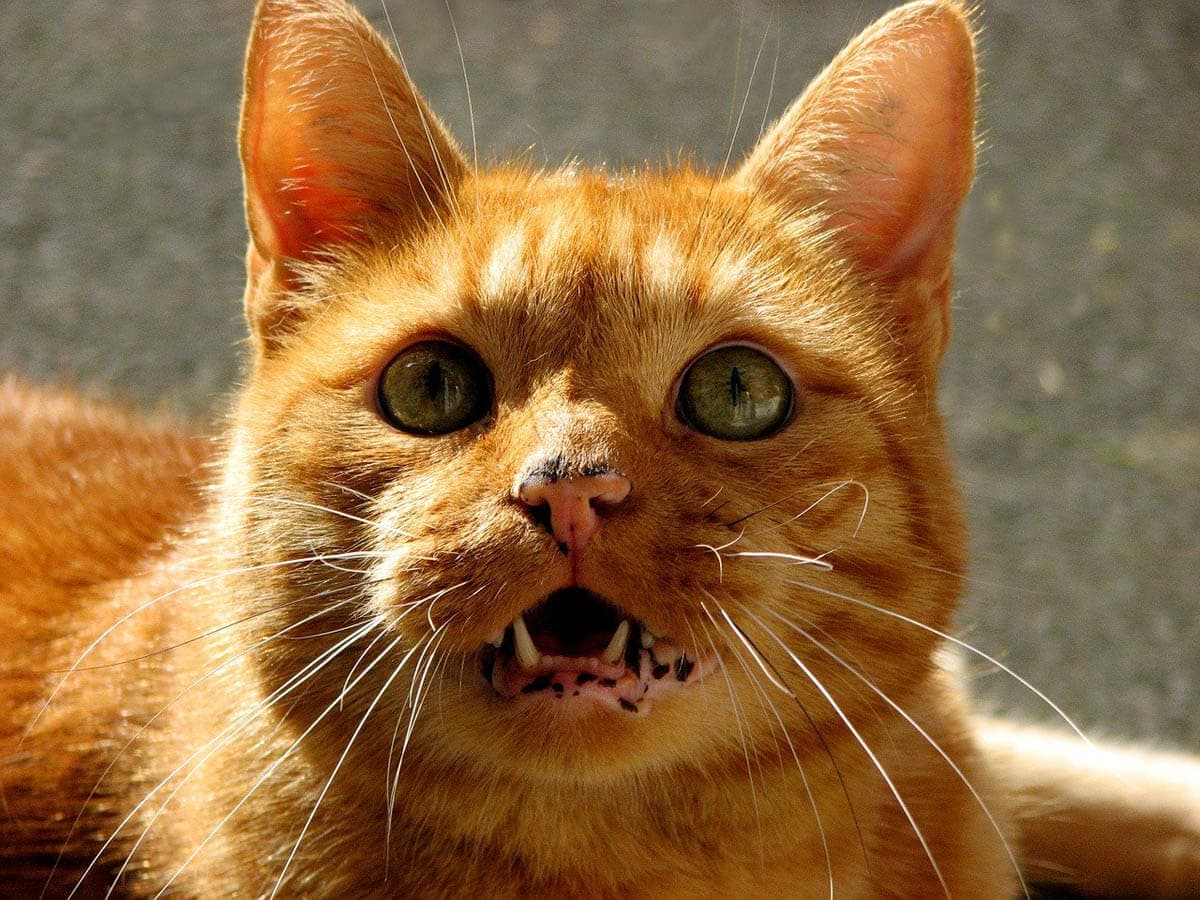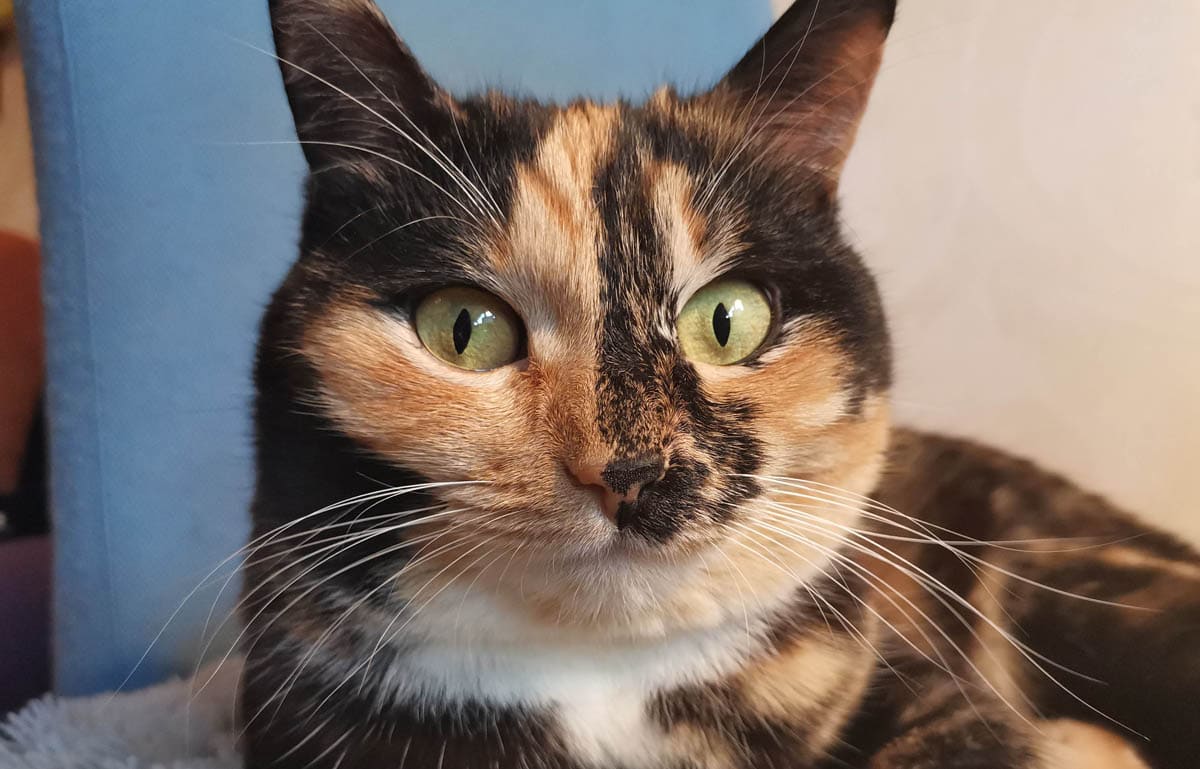Melanoma is a rare type of tumour that arises from pigment-producing melanocytes which can be benign or malignant. 50% are malignant (malignant melanomas) and highly metastatic, which means they readily spread to other parts of the body, such as the lungs, liver, brain, spleen, and bone.
Malignant melanoma statistics
- Melanomas comprise less than 0.8 to 2.7% of all feline tumours.
- Ocular and oral melanomas tend to be more malignant than skin melanomas.
- 1% of oral tumours and less than 0.5% of skin tumours are melanomas; they tend to develop on highly pigmented parts of the skin.
- Malignant melanomas are the most common type of intraocular tumour.
- There is no breed or sex predilection; the mean age for ocular melanoma is 11-12 years.
Ginger and red cats are commonly affected by benign melanocytic hyperplasias, or lentigo, in which heavily pigmented flat spots appear on the lips, nose and eye margins.
 Benign pigmented spots can also develop in the eyes (iris melanosis). While iris melanosis is benign, in some cases can transform into a malignancy. Cats with iris melanosis should be regularly evaluated by a veterinarian or specialist veterinary ophthalmologist to monitor their progress. Glaucoma (increased intraocular pressure) is also a risk factor for cats with iris melanosis.
Benign pigmented spots can also develop in the eyes (iris melanosis). While iris melanosis is benign, in some cases can transform into a malignancy. Cats with iris melanosis should be regularly evaluated by a veterinarian or specialist veterinary ophthalmologist to monitor their progress. Glaucoma (increased intraocular pressure) is also a risk factor for cats with iris melanosis.

Causes of melanoma in cats
Unlike humans, sun exposure doesn’t appear to increase the incidence of melanoma in cats; however, sun exposure does cause squamous cell carcinoma, so it is vital to take care, especially with pale cats or cats with sparse fur (such as the Sphynx).
There may be a genetic predisposition to malignant melanoma.
Melanoma has been induced in cats who were experimentally injected with a strain of feline sarcoma virus.
Symptoms
Common melanoma sites include the head, eyes, eyelids, oral cavity and toes. Ocular melanomas are more common than skin or oral melanomas and are more likely to be malignant.
Symptoms will vary depending on the location of the tumour but may include:
Skin melanomas:
- Single, raised growth which grows rapidly, which may be pigmented
- Common locations include the head, ears, toes, and scrotum of intact males
- Bleeding and ulceration
Eye melanomas:
- Pigmented, raised spots in the iris (the coloured part) of the eye which have a velvety appearance
- Enlargement of the eyeball
- Distortion of the pupil (the black portion of the eye)
- Excessive tearing
- Pain
Mouth:
- Bad breath
- Drooling
- Reluctance to eat
- Facial swelling
- Bleeding and ulceration
- Weight loss
As the tumour spreads through the body, additional symptoms can develop, such as:
- Lethargy
- Weight loss
- Difficulty breathing
Diagnosis
The veterinarian will perform a complete physical examination and obtain a medical history from you, which will include how long the lump has been present and any other symptoms you have noticed.
Diagnostic workup:
Baseline tests: Biochemical profile, complete blood count and urinalysis to evaluate the organs and the health of the cat.
Ophthalmoscope or slit lamp examination: For cats with suspected ocular (eye) melanoma, the veterinarian will carefully and thoroughly examine the eye.
Fine needle aspirate: A needle removes a small sample of the tumour for microscopic evaluation.
Excisional biopsy: If the fine needle aspirate does not provide conclusive results, or if the veterinarian strongly suspects a malignant melanoma, surgical removal, with a wide margin may be performed under anesthesia. The tumour will be sent to a pathologist for evaluation and staging.
Xray or ultrasound: If the cat has a malignant melanoma, a thoracic (chest) and abdominal x-ray or ultrasound will be necessary to determine if the tumour has spread.
Treatment
The earlier the treatment starts, the better. Treatment depends on the location of the tumour, sadly malignant melanomas are very aggressive, and the prognosis is poor even with treatment.
Surgery: If the size and location permit, surgical removal of skin melanomas with a wide margin. Ocular melanomas will necessitate surgical removal of the eye (enucleation). Affected local lymph nodes will also be removed at this time and tissues will be sent to a laboratory for histopathology (microscopic evaluation of the tissues).
Laser therapy: To treat small iris melanomas. A diode laser destroys ocular tumour cells.
Electrochemotherapy: An emerging treatment that shows great promise for the treatment of skin tumours. Chemotherapy drugs are poorly absorbed, this treatment allows for better penetration by delivering electric impulses into the tumour after administration of chemotherapy
Radiation therapy: If it is not possible to remove the tumour, radiation can help to shrink it.
Melanoma vaccine: This vaccine uses human DNA to stimulate the cat’s immune system to recognise melanoma as foreign. The vaccine routinely used in dogs and horses, but there is not much research on the effectiveness of the vaccine in cats. Hopefully, this vaccine will provide treatment for cats soon.
Home care
It will be necessary for your cat to wear an Elizabethan collar at home to prevent trauma to the surgical site. The veterinarian will also prescribe painkillers and antibiotics, administer as prescribed.
- Keep the cat inside during the recovery period.
- Watch for signs of infection such as redness, swelling, and oozing and contact the veterinarian if you notice any changes.
- Regular follow up visits will be necessary to evaluate the cat. Follow up x-rays or ultrasound may be necessary.
- If you notice the tumour re-grows, seek veterinary attention immediately.

